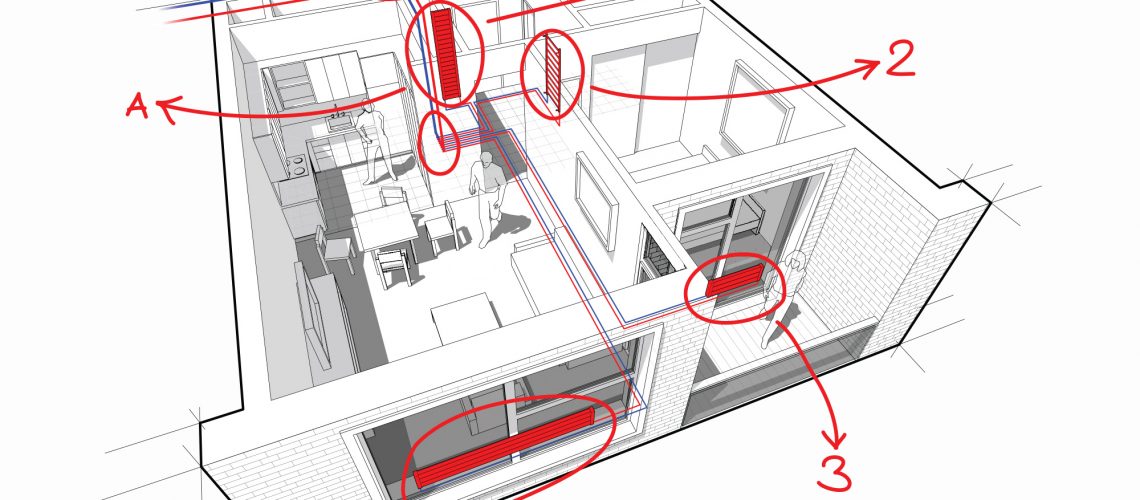How should you heat each room may seem a rather pointless blog to compose. Most homes have a heating source available. This provides heat to the room, thus questioned answered. However, there may be more to this than first thought.
Room Function
Each room in the home has a different function. In this blog, we want you to think about each room in your home consider how well each room performs. Kitchens are warmed through cooking, bathrooms need heating for comfort when washing. Social living spaces will heat up through combined body heat and additional heat sources. Even the bedrooms; everyone has their own sleeping preferences.
This got us thinking about how we should approach heating each room in the home. With the modern advances in heating technology, can there be an ideal way to set up the heating system to provide the right levels of heat to each room?
Central Heating Options
There are of course ways to do this if there are no concerns with budget. In theory, each room could have its own room thermostat linked to a control valve to supply hot water to the radiator. In certain circumstances, this would make sense, especially if underfloor heating is used throughout the property. For the average house in the UK, this would be a very costly installation and would need additional space for the heating components. The purpose of this blog is help you identify issues that may be causing a problem with particular rooms. It will also identify quick fixes you can do right away.
First of all let’s look at the room itself:
The Room
- Does the room get warm enough? Is the central heating providing sufficient heat?
- What is it used for? Sleeping, cooking, washing etc.
- How large is the room? Will it warm up quickly and stay warm?
- How high are the ceilings? Heat rises so this is an important factor.
- Where is the room in the house? Outside walls are colder, therefore, it requires more heat.
- Is it upstairs, ground floor or basement? Airflow and heat rising will influence the room level.
- How much wall space is used by a window? Windows typically lose heat quicker so this needs considering.
- Do you have single, double or triple glazing? The better the glazing the less heat loss.
- What space is there in the room for radiators? A lack of wall space could lead to an undersized radiator.
Internal factors
- Are carpets in the property? Carpets provide good insulation.
- Do you have curtains? Curtains can shield the heat loss from a window thus preventing excessive heating.
- Are there any vents to outside? Excessive cold air from outside causes drafts and therefore hinders the heating system.
- How many people occupy the room? Human body heat can significantly alter a room temperature.
- What draft protection is there in the room? Too much air circulation increases the heating demand.
- Is there a hot water cylinder in the room or next to the room? The heat from a cylinder can affect the performance of a heating sensor.
- Is the boiler in the room? Also, same as the cylinder.
- How important is the aesthetics of the radiator? Is the style of the radiator compromising the heat output?
Efficiency Considerations
- How much are your energy bills? Click here for a comparison.
- Is the house detached, semi-detached, terrace or flat? Are the walls heated by other properties?
- Is there any loft insulation? A blanket trapping heat in the home will significantly improve heating.
- Does the room connect to any other room? Opening doors frequently will change the heat in a room, for instance in a hallway.
- Does any of the walls house a chimney? If a chimney is used this can radiate heat into a room.
- Are there any other forms of heat sources in the room? Electrical devices, cooking, refrigeration.
- How old is the boiler? Can it cope with the heating demands; the boiler maybe working while the radiators are cool
- Are your radiators warm throughout the house? Is the central heating circulating properly?
- Are they cold at the top or the bottom? Your system could be full of air or sludge .
- How old are the radiators in the house? They may be made from thicker metals and take longer to heat up.
- Do the existing radiators have ‘fins’ at the back? Fins provide added surface area to a radiator.
If you would like help with your heating or you are thinking about an upgrade, please get in touch!


